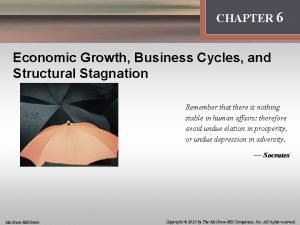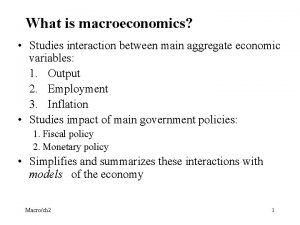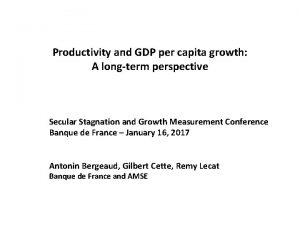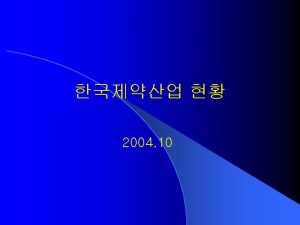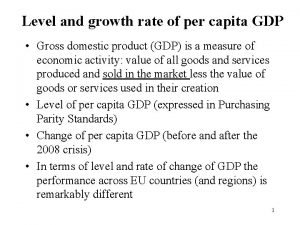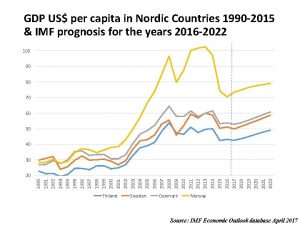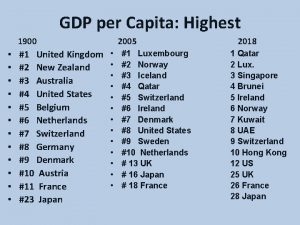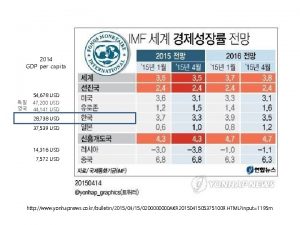Productivity and GDP per capita growth A longterm






















- Slides: 22

Productivity and GDP per capita growth: A long-term perspective Secular Stagnation and Growth Measurement Conference Banque de France – January 16, 2017 Antonin Bergeaud, Gilbert Cette, Remy Lecat Banque de France and AMSE

Productivity and GDP per capita growth: A long-term perspective Underlying papers: From Antonin Bergeaud, Gilbert Cette and Remy Lecat - 2012”, The Review of Income and Wealth, Vol. 62(3), September, pp. 420444 - (2016): “The role of production factor quality and technology diffusion in the 20 th century productivity growth”, Cliometrica, Forthcoming - (2015): « GDP per capita over the 20 th century in advanced countries » , Banque de France, Working Paper n° 549, April. 2

Productivity and GDP per capita growth: A long-term perspective Outline 1. Introduction - TFP: A measure of our ignorance 2. TFP growth changes from 1890 to 2015 3. Factors of TFP growth 2. 1. What have we done? 2. 2. The data 2. 3. The results 4. Concluding remarks 4. 1. Takeaways 4. 2. A more complete story 3

1. Introduction - TFP: A measure of our ignorance Ø 20 th century: a period of exceptional growth Ø What drives the evolution of growth? Abundant literature. See among others Aghion and Howitt (1998, 2006, 2009) Ø Bergeaud, Cette and Lecat (2015): usual growth accounting methodology GDP growth = Labour productivity growth = TFP growth + Capital deepening contribution + Number of worked hours growth = Employment growth + Hours per worker growth 4

1. Introduction - TFP: A measure of our ignorance GDP annual growth (in %) and contributions (in pp) – Whole economy Source: Bergeaud, Cette and Lecat (2015) 8. 5 8. 0 7. 5 7. 0 6. 5 6. 0 5. 5 5. 0 4. 5 4. 0 3. 5 3. 0 2. 5 2. 0 1. 5 1. 0 0. 5 0. 0 -0. 5 -1. 0 -1. 5 18 90 19 -191 13 3 19 -195 50 0 19 -197 75 5 19 -199 95 5 20 -200 05 5 18 -201 90 5 19 -191 13 3 19 -195 50 0 19 -197 75 5 19 -199 95 5 20 -200 05 5 -2 01 5 8. 0 7. 5 7. 0 6. 5 6. 0 5. 5 5. 0 4. 5 4. 0 3. 5 3. 0 2. 5 2. 0 1. 5 1. 0 0. 5 0. 0 -0. 5 -1. 0 -1. 5 USA TFP Euro Area United Kingdom Capital deepening Japan Population o Main GDP growth driver: Productivity growth. And within productivity: TFP growth o Since WW 2, growth decrease in the four main economic areas except for 1995 -2005 in US and UK thanks to ICT o Main factor of this growth decrease: TFP slowdown. Risk of Secular Stagnation? 5

1. Introduction - TFP: A measure of our ignorance Ø TFP: lion’s share of labour productivity and GDP per capita growth since 1890 Ø But TFP = residual, once only two inputs are used: capital and labour TFP encompasses the role of all the other inputs and measurement errors Such inputs are for example human capital, institutions, technology. . . Ø Two questions raised in the paper o 1 st question: What are the main TFP growth changes from 1890 to 2015? o 2 nd question: What are the main TFP growth drivers? Ø Data used: o Described in Bergeaud, Cette and Lecat (2016) o Many sources from historians and economists o Own capital evaluation through permanent inventory model o Details on sources and productivity indicators available in free access at: www. longtermproductivity. com 6

2. TFP growth changes from 1890 to 2015 Average annual growth rate of TFP (In %) Smoothed indicator (HP filter, λ = 500) - Whole economy Source: Bergeaud, Cette and Lecat (2016) 5 4 3 2 1 18 9 18 0 9 19 5 0 19 0 0 19 5 1 19 0 1 19 5 2 19 0 2 19 5 3 19 0 3 19 5 4 19 0 4 19 5 5 19 0 5 19 5 6 19 0 6 19 5 7 19 0 7 19 5 8 19 0 8 19 5 9 19 0 9 20 5 0 20 0 0 20 5 1 20 0 15 0 United States o US: one big wave over the XXth Century, pause during Great Depression, small wave between 1995 -2005, huge slowdown from the mid 2000 s 7

2. TFP growth changes from 1890 to 2015 Average annual growth rate of TFP (In %) Smoothed indicator (HP filter, λ = 500) - Whole economy Source: Bergeaud, Cette and Lecat (2016) 5 4 3 2 1 18 9 18 0 9 19 5 0 19 0 0 19 5 1 19 0 1 19 5 2 19 0 2 19 5 3 19 0 3 19 5 4 19 0 4 19 5 5 19 0 5 19 5 6 19 0 6 19 5 7 19 0 7 19 5 8 19 0 8 19 5 9 19 0 9 20 5 0 20 0 0 20 5 1 20 0 15 0 United States Euro Area o US: one big wave over the XXth Century, pause during Great Depression, small wave between 1995 -2005, huge slowdown from the mid 2000 s 8 o Euro Area: delay for the big wave, no small wave, huge slowdown from the mid 2000 s

2. TFP growth changes from 1890 to 2015 Average annual growth rate of TFP (In %) Smoothed indicator (HP filter, λ = 500) - Whole economy Source: Bergeaud, Cette and Lecat (2016) 5 4 3 2 1 18 9 18 0 9 19 5 0 19 0 0 19 5 1 19 0 1 19 5 2 19 0 2 19 5 3 19 0 3 19 5 4 19 0 4 19 5 5 19 0 5 19 5 6 19 0 6 19 5 7 19 0 7 19 5 8 19 0 8 19 5 9 19 0 9 20 5 0 20 0 0 20 5 1 20 0 15 0 United States Euro Area United kingdom o US: one big wave over the XXth Century, pause during Great Depression, small wave between 1995 -2005 o Other countries: delay for the big wave, no small wave except for the UK 9 o Huge slowdown from the mid 2000 s in all areas: Risk of Secular Stagnation?

2. TFP growth changes from 1890 to 2015 Average annual growth rate of TFP (In %) Smoothed indicator (HP filter, λ = 500) - Whole economy Source: Bergeaud, Cette and Lecat (2016) 5 4 3 2 1 18 9 18 0 9 19 5 0 19 0 0 19 5 1 19 0 1 19 5 2 19 0 2 19 5 3 19 0 3 19 5 4 19 0 4 19 5 5 19 0 5 19 5 6 19 0 6 19 5 7 19 0 7 19 5 8 19 0 8 19 5 9 19 0 9 20 5 0 20 0 0 20 5 1 20 0 15 0 United States Euro Area United kingdom Japan o US: one big wave over the XXth Century, pause during Great Depression, small wave between 1995 -2005, o Other countries: delay for the big wave, no small wave except for the UK 10 o Huge slowdown from the mid 2000 s in the all areas : Risk of Secular Stagnation?

2. TFP growth changes from 1890 to 2015 Abundant related literature Ø Main factors of growth over the long-run and their impact: widely studied subject Ø Some examples (among others): o On all aspects, Aghion and Howitt (1998), and their following publications o Education - Madsen (2014): education explains 0. 48 points of the 1. 87% average growth in GDP per capita; Wide related literature estimating the return of education on growth over the long run (Barro and Lee, 1992, 2010; Morisson and Murtin, 2010; Cohen and Soto, 2007; …) o Institutions – Barro (xxxx): important role; Prados (2015): new database on economic freedom and institutions over the long run o Technology - Comin and Mestieri (2013) and Comin and Hobijn (2010): importance of technology adoption to explain divergence between economies; Madsen (2010): importance of technology spillovers using patent data o … Ø Large uncertainties on TFP growth factor contributions and future scenarios… 11

3. Factors of TFP growth 3. 1. What have we done? Ø Analysis of TFP growth over the period 1890 -2013 in 17 advanced economies: o G 7 countries + Spain, Netherlands, Belgium, Finland, Portugal, Australia, Sweden, Norway, Switzerland Denmark o We reconstituted a Euro Area using 8 countries: DEU, FRA, ITA, ESP, NDL, BEL, FIN, POR (93% of the 2010 EA GDP) o Large focus on the comparison between 4 main areas: USA, Euro Area, UK and Japan Ø 1 st Step: Usual measurement of TFP with capital and labor as inputs. Ø 2 nd Step: Measurement of TFP’ = TFP purged from the impact of … o … human capital o … age of capital influence Econometric IV approach Ø 3 rd Step: Measurement of TFP’’ = TFP’ minus the impact of … o … 2 nd industrial revolution GPT innovation (electricity) o … 3 rd industrial revolution GPT innovation (ICT) Econometric IV approach 12

3. Factors of TFP growth 3. 2. The data Average of capital equipment (In years) - Whole economy Source: Bergeaud, Cette and Lecat (2014) 10 9 8 7 6 5 4 20 19 26 19 32 19 38 19 44 19 50 19 56 19 62 19 68 19 74 19 80 19 86 19 92 19 98 20 04 20 10 19 14 19 08 19 02 19 96 18 18 90 3 United States Euro Area United Kingdom Japan 13

3. Factors of TFP growth 3. 2. The data Average years of studies of the working age population (In years) Whole economy Source: Van Leewen and Van Leewen-Li (2014) 14 12 10 8 6 4 2 18 7 18 0 7 18 5 8 18 0 8 18 5 9 18 0 9 19 5 0 19 0 0 19 5 1 19 0 1 19 5 2 19 0 2 19 5 3 19 0 3 19 5 4 19 0 4 19 5 5 19 0 5 19 5 6 19 0 6 19 5 7 19 0 7 19 5 8 19 0 8 19 5 9 19 0 9 20 5 0 20 0 0 20 5 10 0 United States Euro Area United Kingdom Japan 14

3. Factors of TFP growth 3. 2. The data Electricity production per capita - Whole economy Source: Bergeaud, Cette, Lecat (2015) 16 14 12 10 8 6 4 2 18 70 18 77 18 84 18 91 18 98 19 05 19 12 19 19 19 26 19 33 19 40 19 47 19 54 19 61 19 68 19 75 19 82 19 89 19 96 20 03 20 10 0 United States Euro Area United Kingdom Japan 15

3. Factors of TFP growth 3. 2. The data ICT share in capital equipment – Current value (In %) Source: Bergeaud, Cette, Lecat (2016) 12 10 8 6 4 2 19 50 19 53 19 56 19 59 19 62 19 65 19 68 19 71 19 74 19 77 19 80 19 83 19 86 19 89 19 92 19 95 19 98 20 01 20 04 20 07 20 10 0 United states Euro area United kingdom Japan 16

3. Factors of TFP growth 3. 3. Results Average annual growth rate of TFP, TFP’ and TFP’’ in the United States (In %) Smoothed indicator (HP filter, λ = 500) - Whole economy Source: Bergeaud, Cette and Lecat (2016) 18 1890 1995 1900 1905 1910 1915 1920 1925 1930 1935 1940 1945 1950 1955 1960 1965 1970 1975 1980 1985 1990 2095 2000 2005 10 4 3. 5 3 2. 5 2 1. 5 1 0. 5 0 -0. 5 TFP 17

3. Factors of TFP growth 3. 3. Results Average annual growth rate of TFP, TFP’ and TFP’’ in the United States (In %) Smoothed indicator (HP filter, λ = 500) - Whole economy Source: Bergeaud, Cette and Lecat (2016) 18 1890 1995 1900 1905 1910 1915 1920 1925 1930 1935 1940 1945 1950 1955 1960 1965 1970 1975 1980 1985 1990 2095 2000 2005 10 4 3. 5 3 2. 5 2 1. 5 1 0. 5 0 -0. 5 TFP' o Among factor quality indicators: education levels have the largest contribution to growth, age of capital has a significant, albeit limited role 18

3. Factors of TFP growth 3. 3. Results Average annual growth rate of TFP, TFP’ and TFP’’ in the United States (In %) Smoothed indicator (HP filter, λ = 500) - Whole economy Source: Bergeaud, Cette and Lecat (2016) 18 1890 1995 1900 1905 1910 1915 1920 1925 1930 1935 1940 1945 1950 1955 1960 1965 1970 1975 1980 1985 1990 2095 2000 2005 10 4 3. 5 3 2. 5 2 1. 5 1 0. 5 0 -0. 5 TFP'' o Among factor quality indicators: education levels have the largest contribution to growth, age of capital has a significant, albeit limited role o Among technology shocks, electricity has the largest contribution; ICT contribution is limited o All adjustments proposed amount to less than half of TFP growth 19

4. Concluding remarks 4. 1. Takeaways Ø TFP growth waves: main driver of LP and GDP growth waves Ø TFP growth waves and recent TFP growth decline only partly explained by factor quality adjustment and by technology impact measurement Difficult diagnosis concerning the supply side Risk of Secular Stagnation Ø Factor quality measurement and technology shock measurement are still problematic Mismeasurement of price decline of capital goods => Mismeasurement of capital-deepening and consequently of TFP 20

4. Concluding remarks 4. 2. A more complete story Ø Long-term productivity slowdown could be related to other factors Ø For example real interest rates, see following Graph See Cette, Fernald and Mojon (2016) Ø Research program at the Banque de France: Circular relation between TFP growth and real interest rates? Real interest rates + factor quality + (institutions, technology) => TFP growth + other factors (demography …) => GDP growth => real interest rates Without technology shocks and adapted institutions, risk of Secular Stagnation Ø A part of TFP growth will remain unexplained, at least from externalities (“manna from heaven”) 21

4. Concluding remarks Real long-term interest rate (In %) 10 -year sovereign bonds Source: Jordà- Schularick-Taylor Macrohistory Database 16 14 12 10 8 6 4 2 United States Euro Area United Kingdom 10 20 05 20 00 20 95 19 90 19 85 19 80 19 75 19 70 19 65 19 60 19 55 19 19 50 0 Japan 22
 Yugoslavia gdp
Yugoslavia gdp Real gdp per capita formula
Real gdp per capita formula Per capita real gdp formula
Per capita real gdp formula Calculate real gdp per capita
Calculate real gdp per capita Imf gdp per capita
Imf gdp per capita What is nominal gdp
What is nominal gdp Per stirpes v per capita
Per stirpes v per capita Per capita vs per stirpes
Per capita vs per stirpes Real gdp and nominal gdp
Real gdp and nominal gdp Real gdp formula
Real gdp formula Modern per stirpes
Modern per stirpes Per capita
Per capita Qué es el pib per cápita
Qué es el pib per cápita Lts stable
Lts stable Thomas silverstein art
Thomas silverstein art Gdp formula
Gdp formula What is plant growth analysis
What is plant growth analysis Root hair structure
Root hair structure Primary growth and secondary growth in plants
Primary growth and secondary growth in plants Primary growth and secondary growth in plants
Primary growth and secondary growth in plants Tipologia c
Tipologia c Capita sims alumni
Capita sims alumni Belladonnae radix
Belladonnae radix


